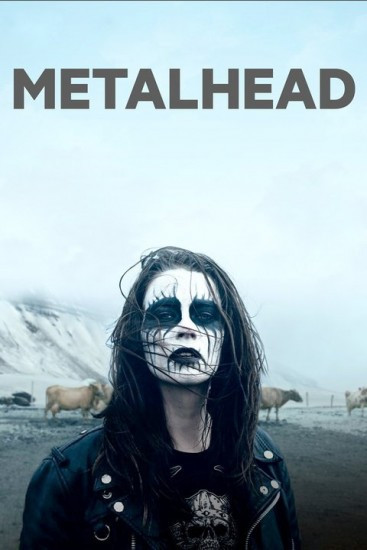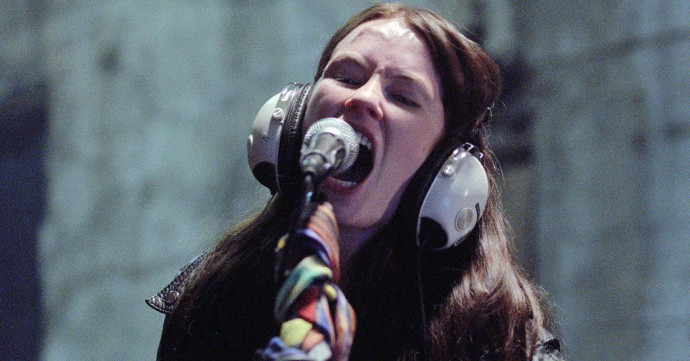(This post is by Grant Skelton, and he will explain what it’s about.)
After several years, I’m finally back in school finishing out a Bachelor’s. This was an essay I wrote for a journalism class called “Mass Media & Cultures.” In a nutshell, the course covered communication of news messages between (or about) different cultures and how those messages are framed.
My assignment for this essay was to “select a commercial movie that deals with either a culture clash or attempts to depict another culture and discuss the effect this film and its message might have on an average adult viewer.”
I chose the 2013 Icelandic film Metalhead, directed by Ragnar Bragason. One of the class textbooks I refer to is Jaap van Ginnekin’s Understanding Global News: A Critical Introduction. I include these details just to provide some context for the assignment. I really enjoyed writing this paper, because metal culture is still largely misunderstood by the public at large. Most of that misunderstanding has been informed by media platforms that frame heavy metal culture as something that is an antagonistic, subversive art form that directly contributes to acts of violence. But that’s a topic for another day.
A fair warning, this essay does contain some spoilers about Metalhead. It isn’t my intention to ruin the film for anyone who hasn’t seen it, but the paper would have been impossible to write without revealing some of the elements of the film’s plot. You can rent “Metalhead” on Amazon for $3.99. The DVD looks to be about $13. I haven’t seen it on Netflix or Hulu.
And now for the essay.
This paper covers Ragnar Bragason’s film Metalhead, in which the protagonist’s interest in heavy metal music clashes with the culture of her small town. The paper will review the film’s depiction of the heavy metal subculture, the protagonist’s interpersonal connection to it, and how her music affects her community at large. We will also consider what effect this film and its message might have on an adult viewer.
Set in a rural Icelandic community, Metalhead follows Hera, a misunderstood twenty-something who finds catharsis in heavy metal music. The opening scene of the film shows the tragic death of Baldur, Hera’s older brother. After witnessing Baldur’s death firsthand, Hera retreats into Baldur’s bedroom. She has a flashback of her brother playing guitar and writing music. Surrounded by posters of Iron Maiden, Judas Priest and the like, Hera dons one of Baldur’s heavy metal T-shirts. She listens to his records and becomes captivated by the music. As years pass, Hera’s interest in heavy metal follows her into adulthood. She learns to play guitar, and writes and records crude demos in the barn on her parents’ farm.
Baldur’s death leaves a void in the lives of Hera and her parents. After Baldur’s funeral, Hera enters his room and plays his guitar. Music is a form of media, and Hera gains use and gratification from heavy metal. Of the 4 uses and gratifications that van Ginnekin lists in the text, Hera finds 2: personal identity and integration and social interaction (van Ginnekin, p. 194). Hera feels a connection to her lost sibling. In place of her internal grief for his loss, she identifies herself by heavy metal culture, its images and symbols, and its dress. As an adult, Hera wears Baldur’s leather jacket, ripped blue jeans and black boots. Throughout the course of the film, Hera wears various heavy metal band T-shirts. These T-shirts are a vital symbol in the heavy metal subculture. If the rest of Hera’s clothing did not identify her as a fan of heavy metal music, her T-shirts remove any doubt. Skulls, pentagrams, inverted crosses, devils and the like are but a few of the common imagery associated with heavy metal music.
These symbols serve another purpose for Hera. Her interactions with others, coupled with her identity as a heavy metal fan, forge her world into polarity. She develops a rigid “I versus them” mentality about her community (van Ginnekin, p. 196). Heavy metal symbolism allows Hera to define herself by what she is not. Her identity must be different, or other than, the larger culture of her town. Hera sarcastically tells her father that she is a lesbian. She is fired from a job after playing Riot’s “Run For Your Life” over the business’ PA system. Some of Hera’s behaviors are aberrant, even deviant in nature. After a late-night drinking binge, Hera steals a neighbor’s tractor. She commits arson twice in the film. These behaviors, and the reactions of her parents and the community at large, deepen Hera’s commitment to her identity and sense of belonging to something greater than herself. Even if that sense of belonging makes daily life difficult for her and those around her. When Hera practices playing guitar, the viewer observes her playing the lead solo and introductory riffs to Diamond Head’s “Am I Evil?” While a viewer uninitiated to this era of heavy metal music might miss this reference, this song is an apropos choice given its context in Hera’s life. In one scene, Hera is in her bedroom listening to Lizzy Borden’s “Me Against The World” (Borden and Allen). The song’s chorus includes the lyrics:
Cause I am for real
You don’t know what I feel
My strength is in my will
I can not wait
I won’t be second rate
In for the kill
It’s me against the world
The media that a person does or does not expose themselves to depends upon what cognitive script a person uses to make sense of reality. Quoting from Phillips (1981) and Sullivan et al. (1988), van Ginnekin writes, “‘schemata’ were postulated as ‘mini-systems by which the individual internalizes, structures and makes sense of an event” (van Ginnekin, p. 197). Furthermore, “‘Scripts’ were postulated which organize our knowledge with regard to a certain routine course of action.” In the text, van Ginnekin notes four consequences for these cognitive theories. The first, second and fourth consequences are relevant to the way that Hera makes sense of Baldur’s passing by assimilating into heavy metal culture. Continuing on p. 197 he explains:
First, we will only expose ourselves (that is, perceive, retain and reproduce) to the information about other cultures and social systems that we can make sense of.
Second: we tend to fit this information about other people and groups into configurations which are meaningful in our own group….
Fourth: we will organize such ideas into coherent scripts….
After Baldur’s death, Hera creates an internal script, a way that she organizes reality and attaches meaning to her grief. Baldur’s passing has, understandably, left a void in her life. Through heavy metal music, she is able to feel a connection to him that she did not previously have. She is able, in a sense, to keep Baldur alive, commemorating his memory by becoming like him, dressing like him, and enjoying his music. She visits Baldur’s grave religiously, even performing some of her original musical compositions for him.
But even deeper than that, the music itself provides Hera with a narrative that helps her to process grief and organize her life into something meaningful. Metal helps Hera create a worldview, a filter through which she signitively discerns and judges meaning and purpose. When Hera speaks with Janus, the local priest, she says,”He [God] owes me.” She tells Janus that, “The Church has always belittled these bands…you say that they all worship Satan and such. But if you’d listen to the lyrics…they’re about reality. Death is real, war is real. It tells things like they really are without sugarcoating” (Bragason). Hera’s internal narrative defines her (heavy metal) by what she is not (the Church), as we discussed earlier. She blames God, at least in part, for Baldur’s death and is at odds with Him and the iconography and persons who speak on His behalf. Hera makes conclusions about God, the Church, and about Janus himself.
Hera measures the behavior of Janus, identifying him with the “other” group. Hera makes a judgment about Janus and measures the behavior of his group against her own, marking his as inferior and hers as superior (van Ginnekin, p. 198). She says that the lyrical topics in heavy metal music are “about reality.” In the music, she finds a representation of reality that is consistent with, and informed by, how she has come to view reality. In what may be my favorite scene from the film, Janus lowers his shirt to reveal a tattoo of Iron Maiden’s mascot “Eddie” on his left shoulder. Given heavy metal’s interest in mythology, I am inclined to believe that the decision to name the priest “Janus” is not an accident. The Roman god of the same name is often depicted as having two faces (Encyclopaedia Britannica). He is associated with doorways and is thought to represent new beginnings or transitions (Encyclopaedia Britannica).
In conclusion, the effect that this film and its message depend entirely upon the adult viewer. Fans of heavy metal music have a taste for scarcity. They have a passion and a zeal for the rare and arcane. If the adult viewer is a fan of heavy metal music, or at least has a working knowledge of it, I estimate that they would enjoy the film and identify with Hera’s plight. This is especially true of older adult metal fans who grew up during the time period of the film’s events. The news story that Hera watches about the Norwegian black metal scene and its association with church burnings has real historical precedence (Bagnall). Fans of that era of heavy metal will likely resonate with the film. On the other hand, if the adult viewer is a casual viewer the film’s message will pass unnoticed. The viewer will likely respond the way that Hera’s community does when she performs an original black metal song for them. “It’s way too loud! We can’t hear a word of what you’re singing” (Bragason).
Works Cited
Borden, Lizzy and Allen, Gene. “Me Against The World.” Metal Blade Records, 1987. Digital.
Bragason, Ragnar, dir. Metalhead. Cinelicious Pics, eOne Films, 2013. Film.
van Ginnekin, Jaap. Understanding Global News. London: Sage Publications. 1998. Print.
Bagnall, Sam. Investigating The ‘Death Metal’ Murders. BBC News. 23 November 2005. Accessed 17 November 2015. Web.
Encyclopaedia Britannica. Janus: Roman God. Britannica.com. Accessed 18 November 2015.





Bringing metal into academia is always an enjoyable endeavour. Hell, doing that in my UChicago admissions essay is probably the thing that got me in there (not to shamelessly plug in the comments of your fantastic essay, but I posted that essay here a few years back, if you’re interested in reading it). Sadly, I haven’t had the right platform to do that since that admissions essay, though I’m hoping to integrate some of my knowledge of svartmetall into my Norwegian course sometime before the end of the year.
But anyway, this was a great read, Grant. Thanks for posting, and reminding me that I should really try and see this film sometime over my winter break.
Thanks for the positive feedback, dude! I actually WOULD like to read your admissions essay. Feel free to post the link, or tell me the title and I’ll search for it.
I’m the kind of person who takes my music seriously. Metal music has narratives in it that we fans can relate to. And narratives are extremely important.
Here you are, mate. And thanks for the interest:
https://www.nocleansinging.com/2014/04/11/college-essays-metal-and-comparing-fruit/
I imagine I might have to pay BadWolf royalties or something at some point.
Although some of it went over my head (no surprise there) I found this to be a very well written and enjoyable read. I’m very curious to watch the film, now 🙂
Thank you Derek! Do check the film out. I think you’ll enjoy it.
Great post! Like Leperkahn I’m always keen to more metal being covered in an academic context. I particularly like that you’ve come up with this as an example to answer the question about how different cultures are viewed, because as we all know metal is usually misportrayed or misconstrued. Was the lecturer/profs surprised you chose this as an example to write about?
Great essay. I didn’t know about Metalhead before but I’m keen to see it now.
I believe the professor used the term “offbeat” to describe the movie :). And thanks!
An interesting and illuminating read.
Throughout the read, I can’t help but imagine what kind of story I would use to communicate with others (non-metal listeners) about metal music, to set up am image for this type of music–a daunting task if you ask me since metal music as a minority genre is incredibly diverse in terms of the information it conveys and cohorts it captures. I should watch this movie to find some hint.